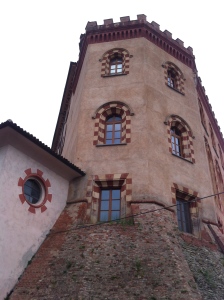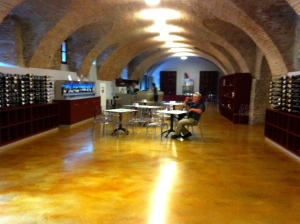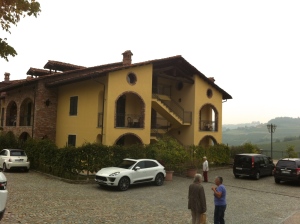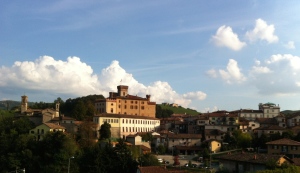 There have been fortifications here since the tenth century. The present castello has its origins in the 13th century. It belonged, of course, to the Falleti family,who seem to have owned everything in the area. They had another castello a few hundred yards up the hill – Castello della Volta – now in ruins. The Commune of Barolo has put the former riding school
There have been fortifications here since the tenth century. The present castello has its origins in the 13th century. It belonged, of course, to the Falleti family,who seem to have owned everything in the area. They had another castello a few hundred yards up the hill – Castello della Volta – now in ruins. The Commune of Barolo has put the former riding school  attached to the castle to good use. It is a beautiful regional showcase for Barolo, with 32 wines for tasting.
attached to the castle to good use. It is a beautiful regional showcase for Barolo, with 32 wines for tasting.
What we learned about Barollo – Piemonte’s (and perhaps Italy’s) premier wine: It is made from Nebbiolo grapes grown only on south-facing slopes on 2,000 hectares of land around Barolo. Wine from slopes with other orientations is bottled as Nebbiolo. Barolo is sold in its fourth year. Grapes grown on the area’s sandier soil produce a lighter, fruitier wine that may be drunk at four years, but is best kept longer and will last about 8 years. Grapes grown on the area’s clay soil produce a more acidic, complex wine that shouldn’t be drunk before its 8th year. It continues to improve and can be held about 20 years. To produce the best wine, springs must be rainy, summers hot and dry and falls warm with cool nights – not the conditions in 2014. With a cool, rainy summer, the next two weeks will be crucial to ripening the grapes. Without enough warm days, there may not be much Barolo bottled this year. Instead it will be bottled and sold as Langhe di Nebbiolo, a less prestigious drink.
 Hotel Barolo has been our home for a week. Its Ristorante Brezza serves good food, breakfasts are more than we should eat, and the location is perfect for exploring this stunning countryside. We will miss our
Hotel Barolo has been our home for a week. Its Ristorante Brezza serves good food, breakfasts are more than we should eat, and the location is perfect for exploring this stunning countryside. We will miss our view over the village and the castello.
view over the village and the castello.
Next stop – Umbria!

Leave A Comment